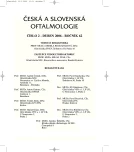The Orbital Implant after Exenteration of the Orbit with the Preservation of the Eyelids and the Conjunctival Sac
Orbitální protéza po exenteraci očnice se zachováním víček a spojivkového vaku
Exenterace očnice představuje v oftalmologii nejvíce mutilující chirurgický výkon. Operační technika prezentovaná autory zachovává víčka i spojivkový vak. Tuto operaci (1986) navrhli a opakovaně provedli u dospělých pacientů s rozsáhlými benigními orbitálními nádory (převážně meningeomy) J. Otradovec a S. Šafář. Zpravidla tomuto výkonu předcházela enukleace bulbu. Výsledný stav umožňoval vkládat do spojivkového vaku protézu. Dnes seznamujeme s dalším vývojem této operace a podle vlastních zkušeností rozšiřujeme její indikaci i na některé maligní nádory (rhabdomyosarkom a metastázy retinoblastomu atd.) u dětí. Počáteční kožní řez se vede v oblasti obočí a směřuje až na kost orbitálního vstupu. Následuje preparace tkáně pod neporušeným spojivkovým vakem k dolnímu okraji kostěného okraje orbity. Po odklopení kožně spojivkového laloku je vlastní obsah orbity klasickým způsobem exenterován. Po hemostáze v hrotu orbity je lalok překlopen zpět na orbitální vchod a operace ukončena sešitím vstupního řezu v jednotlivých vrstvách tkáně. Referují o nyní sedmnáctiletém chlapci, který ve třech letech podstoupil exenteraci očnice pro rhabdomysarkom touto technikou.
Autoři dále seznamují s vývojem a aplikací speciální protézy ze silikonového kaučuku – „implant grade“ vyplňující orbitální prostor a modelující přední segment oka. Protéza vznikla vulkanickým spojením orbitálního implantátu běžně používaného při enukleacích a spojivkového implantátu – konvexně konkávní destičky o průměru 20 mm, které jsou vyrobené ze stejného silikonového kaučuku. Orbitální implantát byl elipticky protažen na základě měření orbitálního prostoru pomocí odlitku ze stomatologické otiskové hmoty. Kosmetická část představující barevnou duhovku i zorničku byla připravena z polyesterové fólie pokryté akrylátovými barvami. Na spojivkový implantát byla přichycena a překryta průhlednou silikonovou fólií. Protéza byla poprvé aplikována v sedmi letech a v následujícím desetiletém období třikrát vyměněna většinou za větší model. Tento postup zaručoval modelaci orbitální oblasti a symetrický vývoj obličeje. Protéza plní také protetickou úlohu přibližující se kosmeticky stavu po klasické enukleaci bez implantátu.
Klíčová slova:
exenterace orbity, orbitální implantát, protetika orbity, silikonový kaučuk, rhabdomyosarkom orbity
Authors:
J. Krásný 1; V. Novák 2; J. Otradovec 3
Authors‘ workplace:
Oční klinika FNKV a IPVZ, Praha
přednosta prof. MUDr. P. Kuchynka, CSc.
1; Ústav polymerů VŠCHT, Praha
vedoucí ústavu prof. Ing. V. Dudáček, DrSc.
2; Oční klinika VFN, Praha, přednostka doc. MUDr. B. Kalvodová, CSc.
3
Published in:
Čes. a slov. Oftal., 62, 2006, No. 2, p. 94-99
Overview
In ophthalmology, the orbital exenteration presents the most mutilating surgical procedure. The surgical technique presented by authors, preserves the eyelids and conjunctival sac. This surgical procedure was suggested and repeatedly performed in adult patients with extensive benign tumors (mostly meningeomas) by J. Otradovec and J. Šafář. The enucleation of the eyeball preceded this type of surgery. The final state made it possible to put the prosthesis into the conjunctival sac. Today we inform about further development of this surgical technique and according to our own experiences we widen its indications to some malignant tumors (rhabdomyosarcoma and metastases of the retinoblastoma, etc.) in children. The initial cutaneous incision starts in the eyebrow area and is directed toward the bone of the orbital rim. The preparation of the tissue underneath the intact conjunctival sac to the lower aspect of the bone orbital rim follows. After folding the conjuctival-cutaneous sac back, the real content of the orbit is exenterated in the classical manner. After the hemostasis in the orbital apex, the flap is returned to its primary position and suturing of the primary incision in anatomical layers terminates the surgery. The authors refer about a boy, now 17 years old, who underwent at the age of three years the exenteration of the orbit in this manner due to a rhabdomyosarcoma.
The authors also refer about the development and application of a special type of prosthesis made from silicone rubber – implant grade – filling out the orbital space and forming the anterior segment of the eye. The prosthesis was created from a classical orbital implant, regularly used in enucleation surgery and a conjunctival implant, a convex-concave plate with diameter of 20 mm. Both parts are made from the same type of silicon rubber and were connected together by vulcanization. The orbital implant was eliptically extended according to the measurements of the orbital casting made from dental impression matter. The cosmetic part, simulating the colored iris and the pupil, was prepared from a polyester sheet, painted with acrylic paint. It was fixated on the conjunctival prosthesis and covered with a transparent silicone foil. For the first time, the prosthesis was applied at the age of seven years, and during the next ten-years period, it was three times exchanged mostly for a bigger model. This procedure guaranteed proper growing of the orbital area and symmetrical development of the face. The prosthesis also carries out the prosthetic role and cosmetically it looks similarly like after the enucleation without the implant.
Key words:
exenteration of the orbit, orbital implant, orbital prosthetic, silicone rubber, rhabdomyosarcoma of the orbit
Labels
OphthalmologyArticle was published in
Czech and Slovak Ophthalmology

2006 Issue 2
Most read in this issue
- Vernal Keratoconjunctivitis and Possibilities its Treatment
- The Orbital Implant after Exenteration of the Orbit with the Preservation of the Eyelids and the Conjunctival Sac
- The Influence of IOL Implantation on Visual Acuity, Contrast Sensitivity and Colour Vision 2 and 4 Months after Cataract Surgery
- Bilateral Retinal Vasculitis with Arterial Aneurysms
